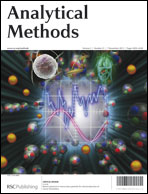Phosphorescence detection of hydrochlorothiazide using Mn-doped ZnS quantum dots
Abstract
The room temperature phosphorescence (RTP) of quantum dots (QDs) offers many advantages compared with fluorescence, such as a longer emission lifetime, wider gap between excitation and emission spectra and minimal interference. Hence, the RTP properties of QDs and their potential for phosphorescence detection have drawn more and more attention. In this paper, N-acetyl-L-cysteine (NAC)-capped Mn-doped ZnS QDs were synthesized by a hydrothermal method. The QDs displayed a strong phosphorescence emission peak at 590 nm upon excitation at 315 nm. Because their RTP was efficiently quenched by hydrochlorothiazide (HCT), a novel RTP method for determination of HCT was developed. The results showed that under the optimized conditions, the changes of RTP intensity showed a good linear relationship with the concentration of HCT in the range of 2.5 to 95 μM, with a limit of detection of 1.25 μM and relative standard deviation of 0.44%. The related theories preliminarily demonstrated the dynamic quenching mechanism. In addition, this method was successfully applied to the analysis of practical samples. The recovery of spiked solutions ranged from 94–104%.


 Please wait while we load your content...
Please wait while we load your content...